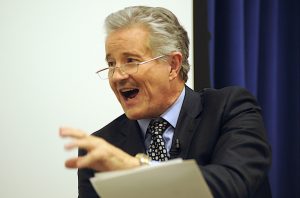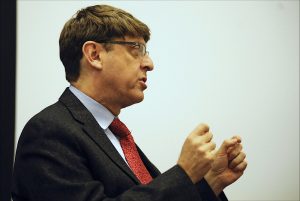Genome Sequencing and Its Clinical Potential Focus of NYC Rare Disease Day Event
Written by |

Dr. Tuuli Lappalainen of Columbia University speaks at the New York Genome Center. (Photo by Larry Luxner)
Genetic sequencing and the speed with which it can help diagnose a child’s disease — in addition to revealing the genes that cause at least half of the 7,000 rare diseases currently known — was the focus of a discussion by three top New York geneticists.
The Feb. 28 conference, “Rare Disease Genetics: Unlocking Insights for All,” was organized by the New York Genome Center to mark Rare Disease Day 2018.
Moderated by Max Gomez, medical correspondent for CBS News, the event featured Tuuli Lappalainen, PhD, a core faculty member at the New York Genome Center and assistant biology professor at Columbia University; Jean-Laurent Casanova, MD, PhD, a professor at Rockefeller University’s St. Giles Laboratory of Human Genetics of Infectious Diseases; and Bruce Gelb, MD, director of the Mindich Child Health and Development Institute, and a pediatrics and genetics professor at Mount Sinai’s Icahn School of Medicine.
Lappalainen noted that rare diseases — which by Europe’s definition affects fewer than one in 2,000 individuals (fewer than 200,000 in the U.S.) — are often inherited, though sometimes they are caused by a new mutation that parents didn’t carry.
“Traditional genetic methods, since the late 1980s, offered sparse mapping and targeted analysis of a few genes. For the past eight or 10 years, we’re doing whole exome sequencing, or analysis of all genes. This gives us a much more dense map of data to find the contributions of genetic variants underlying these rare diseases,” she said. “In the past couple of years, there has been tremendous success in sequencing the whole genome.”
Lappalainen noted situations where two individuals had the exact same genetic variants, but had different outcomes due to environmental and other factors.
“Ultimately, creating a genetic map of rare disease is really important and gives us a platform we can use to develop interventions and medications,” she said.
Gelb’s presentation was on advancing pediatric genomic medicine.
“Cancer is the front line on this. We are clearly learning that the same cancers can result from different mutations,” he said. “And if we concede that cancer is the lowest-hanging fruit, then pediatrics is the second lowest-hanging fruit. The genetic factors that lead to those disorders are quite strong, making them easier to identify, and easier to think about therapies. It gets murkier once you move into adulthood.”
Gelb said next-generation sequencing has made it possible to discover the genes responsible for nearly 300 diseases every year.
“The new model is: we see the child, we suspect a genetic disorder, and rather than doing a whole series of tests, we immediately go to exome or genome sequencing,” he said. “Instead of taking months or years, it takes weeks — and we can solve up to half the cases.”
As an example, Gelb said that last year his clinic saw an 18-year-old woman with autoimmune kidney disease, resulting in the need for a kidney transplant.
“Unfortunately, the exact same disease recurred, destroying the transplanted kidney, and she was back on dialysis,” Gelb said. “She also has a chronic problem with inflammation of her gastrointestinal tract, and a skin rash that comes and goes. When I met her, I noticed that one of her legs was bigger than the other, and for 18 years, her family has been coping with all of this.”
Gelb said that in less than a month, his team was able to pinpoint the underlying problem: a mutation in the JAK1 gene that is known to cause cancer.
“The mutation she was born with is one that’s been tested,” he said, adding that the patient is now being treated with an FDA-approved drug that prevents recurrence in the next kidney transplant.
“It’s getting cheaper and cheaper to do genome sequencing. At a certain point, it’ll stop making sense to do testing for a specific disease,” Gelb said, though he warned that “as a society, we have to be very careful in saying that we’ll just start doing a genome on every baby born. We are quickly going to learn that what we understand about genetics is not the same for many diseases.”
Gelb is one of four principal investigators of an ambitious project to study the impact of genome sequencing on children’s health outcomes and healthcare costs in New York City.
NYCKidSeq, as the four-year research project is known, received $13 million in funding from the National Institutes of Health (NIH) last year. The grant is part of a second phase of CSER2 (Clinical Sequencing Evidence-Generating Research) — a national multi-site program that evaluates the integration of genome sequencing into clinical care.
“Our goal is to integrate cutting-edge sequencing and technology to improve the standard clinical care of children in Harlem and the Bronx,” Gelb said. “Our ultimate goal is to recruit 1,130 kids with problems in three areas: epilepsy, immunological problems, and cardiac problems. We hope to explain how genome sequencing works in the real world.”
Gelb said NYCKidSeq — using seven clinics run by Mount Sinai and Montefiore Medical Center — will evaluate children suspected of having a genetic disease. These kids, he said, often lack access to quality care and lag in benefiting from advances in research and technology.
“Overall,” he said in an August 2017 press release, “this work will inform the genomic and clinical communities about how to implement genomic medicine in a diverse population in a clinically useful, technologically savvy, culturally sensitive, and ethically sound manner.”









